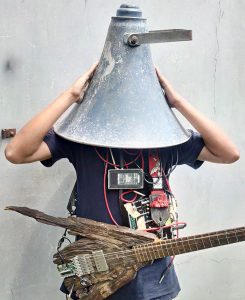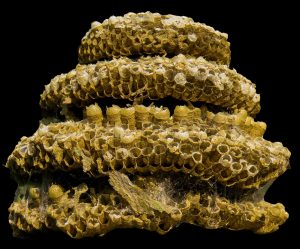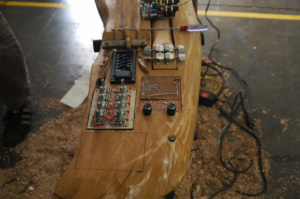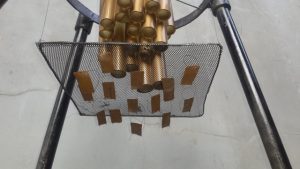The Hive – a conversation with Ikbal Simamora Lubys and Tony Maryana
Tue 29 Aug 2017Would you like to start by letting us know what The Hive is about? People are invited to play this larger-than-life instrument, is that right? The Hive is an interactive instrument. It is intended as a collection of buzzing resonant sounds that sustain a note with gamelan instrument blades. The blade sound is triggered by the vibration generated when people interact with the instrument by vibrating, scratching, hitting, or shaking the object, and the resonance of the buzz is captured inside a large rotating resonator installation.
Do you have any ideas or suggestions about how you would like people to interact the instrument? We invite visitors to Peak Cavern to play with “Kotekan” or “klothekan” or “tetabuhan”. Loosely translated into english this means playing rhythmic patterns freely or improvising by listening to each other and responding to other players resulting in a musical composition. We hope that people will adopt these different modes when playing The Hive.

How did you come to the idea’s behind the work?
When we came to do the first visit of the cave on a site visit to Castleton, Ikbal saw a honey bee hanging in the mouth of the cave and he spoke to me about the idea of a bee hive. I am intrigued by this idea, particularly as the idea of a ‘honeycomb’ sonically connected to ideas of buzzing and recall in my mind. When two blades spaced at different intervals, or a pair of tones are played simultaneously, it creates an acoustic phenomenon called “Ombak”. It roughly translates as “waves” in english. Our idea is that, by using Ombak, we create a “shimmering acoustical beat”. In Balinese gamelan music we call this “contributor”. Contributor is a low tone and “pengisep” (“drafter”) is for high notes (sucker from isep or to suck “). When the contributor and the drafter meet it will result in pulse beat, which is what you will experience as you play The Hive. In my opinion, the sound of the blades meeting produces a beautiful sonic spectrum. At the same time this sound has a depth that can sometimes be very dark, mysterious, or it can be very bright. It will be quite a magical experience.

You are using Gamelan bars to make The Hive. Can you tell me more about Gamelan, and what other music styles and genres influence you in your work?
Gamelan is a family ensemble of musical instruments in Indonesia dominated by metal tools. It is played by beating and is used in formal events (religious ceremonies, ceremonies or royal ceremonies, entertainment, shadow puppet theatre, dance and other cultural events).
The traditional musical instruments of Gamelan developed on the islands of Java and Bali and each region has its own style and way of playing itself.
What was important to us for The Hive, was that Gamelan uses shaped blades (like xylophone or vibraphone blades), large circular gongs with knobs in the centre, and can have a barrel (a kind of pelog or slendro mode or scales).
I did not choose one particular genre or style but I chose based on the acoustic phenomenon of meeting two pelog and slendro barrel to produce beat pulse.
Wukir Suryadi’s Akar Mahoni (Mahogany Root) which Ikbal S. Lubys worked on for The Instrument Builder’s Project, 2013.
Can you tell me about The Instrument Builder’s Project?
The Instrument Builders Project is a collaborative project between artists from Indonesia and Australia. We make an instrument with different artists different background and it has been held three times in Indonesia and Australia.
What are you listening to?
I listen to lots of different types of sounds and I try not to limit anything I listen to. I listen to what I want to hear regardless whether I love the sound or not (whether it is a subjective feeling).

When did you meet and how did you start working together?
We met when we were both studying at the same university. The first time we actually worked together was on a project as part of Yogyakarta Contemporary Music Festival program in 2007. Now we are coming together again to cooperate for this project!
I’m interested that you decided to use physical instruments rather than just sound in your work, what is important about the sculptural elements to your practice?
Now, it’s all important. Musicians do not work just for music alone, the same way that visual artists do not just work in the visual field it’s all blur it seems. Musicians also make designs, and musicians also make visuals or vice versa.
What are you both reading?
I am not a person who likes to read books. When I do read, I read what books I like, like history, biography, or books that I need as a reference, which is usually a music book.

What other projects are you working on at moment?
Ikbal: I’m working on a new project, which I call Musical Journey. I’m also making my second experimental solo album, where I will examine the noise caused by the cone speaker that usually exist in mosque in Indonesia.
Tony: On 26 October, 2017 I have a project call Clitih Beep. Klitih Bunyi is a computer music performance and the “soundscape” examines the space and sound projection and aerial sonic resources. We Play for October Meeting Festival 2017 at Yogyakarta, Indonesia.
Recent Journals
- Introducing Commons // Keiken and Jazmin Morris
- Introducing our Creative Associates programme
- Reflections on the Associate Board Member Programme
- The Future of Arts Governance
- Rendering our virtual, net and digital discourses
- Announcing a new partnership between AND and the School of Digital Arts
- Impossible Perspectives 2024
- AND’s new Board Members and Associate Board Members
- Introducing AND’s new Directors
Other Journals
-
2025
-
2024
-
2023
-
2022
-
2021
-
2020
-
2019
-
2018
-
2017
-
2016
-
2015
-
2014
-
2013
-
2012
-
2011



